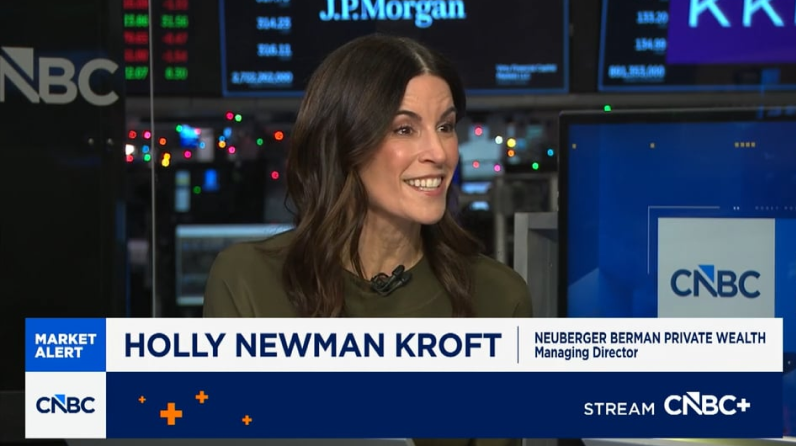

We remain cautious, favoring more defensive positioning within our neutral equity allocation and weightings to higher-quality issues in our fixed income portfolios.
In Short
- The Fed remains steadfast in its inflation fight, with rates likely to be higher for longer.
- Ongoing labor disputes and Congressional leadership instability may act as economic headwinds.
- The rise in energy prices may continue to be a potential inflation risk and could impair consumer spending.
- We remain cautious, favoring more defensive positioning within our neutral equity allocation and weightings to higher-quality issues in our fixed income portfolios.
Higher-For-Longer With Potential Risks Ahead
September was marked by higher-for-longer Federal Reserve (Fed) sentiment and upward pressure on Treasury yields, especially on the longer end of the yield curve. The Fed held interest rates steady in another “hawkish pause” during its FOMC meeting while also indicating that it still expects an additional hike before the end of the year and fewer cuts in 2024 than previously indicated based on rosier economic projections for 2023 and 2024, particularly relating to unemployment. The market, not anticipating the change in interest rate expectations for 2024, reacted by pricing in a “higher-for-longer” implied federal funds rate. For example, the June 2024 implied rate at the beginning of the quarter was about 4.8% compared to roughly 5.2% at the end of the quarter.
With the 10-year Treasury yield reaching 4.8%—its highest level in more than 16 years—and the U.S. dollar index rallying to its highest level since November 2022, the market has seen a risk-off trade since the S&P 500 Index’s peak at the end of July, culminating in its first negative quarter of the year. As discussed in last month’s commentary, the rise in yields was first triggered by the U.S. Treasury when it announced an unexpected ramp-up in debt issuance, further signaling the government’s rising borrowing needs, which contributed to a sell-off in Treasuries. This was compounded by the downgrade of U.S. long-term debt from Fitch Ratings, along with the Fed continuing to shrink its balance sheet through quantitative tightening.
Despite the move in yields, Fed messaging has remained steadfast, with a call for convincing evidence of progress against inflation—something that we believe is starting to be seen in core CPI prints.
U.S. Yield Curve at Start and End of 3Q 2023

Source: Bloomberg, As of September 30, 2023.
During the month of September, all major indices were negative, extending August’s modest declines, with some of the worst trading days of 2023. Still, the calendar may help things moving forward. Historically, the fourth quarter has been the best for equity markets, though not without some turbulence. Since 1988, while the S&P 500 Index’s average return for October is 1.7%, this has been paired with the highest monthly average volatility. That said, in each of the last three years, a negative return in September has preceded a positive return in the fourth quarter. Whether that occurs in 2023 may be a question of positioning and the ultimate depth of the current swoon.
This historical perspective doesn’t mean that October will pass without challenges. One issue could be the UAW strikes that some analysts estimate could lower U.S. GDP growth by 0.2 percentage points every week (see CIO Weekly: Political Gridlock but Fiscal Largesse). Another could be instability out of Washington, DC. In early October, the Congress narrowly avoided a government shutdown by passing a stop-gap spending bill to keep the government open through mid-November. But only days after its passage, the House of Representatives removed Kevin McCarthy as speaker of the House after a handful of Republicans challenged his handling of the budgeting process. Given the uncertainty around Congressional leadership, a shutdown is still possible next month, which could hurt the economy and potentially delay economic data releases.
Earnings season kicks off again in mid-October with a projected 0.2% year-over-year earnings decline for the S&P 500 Index, according to FactSet. If this holds, it will be the index’s fourth consecutive quarter of negative earnings. Interestingly, this outlook for the index is an improvement from recent quarters. Looking forward, such company-level insights may be a useful tool to understand the health of the U.S. economy, particularly the impact of a higher-for-longer Fed alongside sticky-but-cooling inflation and evidence of a modest upswing in manufacturing activity.
A potential increase in consumer headwinds is also on our radar. Federal student loan repayments resume this month, after having been frozen since pandemic relief in 2020 for some 44 million borrowers. A Jefferies survey of consumers with student debt found that roughly 50% are “very concerned about meeting monthly expenses once repayments restart.”1 It is possible that U.S. consumers affected by the resumption of loan repayments will need to cut discretionary spending, especially heading into the holiday shopping season, which would likely be reflected in Q4 earnings. This impact could be compounded by dwindling excess savings, and credit card debt that has reached record highs, even though U.S. household excess net worth stands at $19 trillion.
Energy price spikes (discussed in detail below) may also affect the consumer. National retail gasoline prices rose over 7% during the quarter, reaching $3.84 per gallon nationally, with some regions seeing even greater increases. (California, for example, averaged over $6 per gallon.) A more indirect consequence of higher oil prices is that companies could pass on the cost to customers via prices for goods and services.
Energy Poses Potential Inflationary Challenges
Energy prices remain a large overhang for the broader economy, as the price of oil and other energy-related commodities has trickled down to various areas, affecting measures of inflation like the headline Consumer Price Index (CPI), which assigned a weight of 7% to energy as of July. Oil prices spiked in the third quarter, with WTI crude rising 29% to $90.79 per barrel. New York diesel prices also hit a record seasonal high in September, with futures rising more than 50% from the lows in early May.
While the Fed excludes volatile energy markets when it sets borrowing costs, increases in oil prices affect the inflation of other goods and services. That could contribute to price pressures while slowing the economy—a scenario that the Fed hopes to avoid—and is prompting concern about the potential for another interest rate hike this year. Keep in mind that energy has been a negative contributor to headline CPI for six consecutive months, dampening inflation metrics. This trend may be changing, with energy contributing 65% of August’s month-over-month headline CPI number—its largest contribution since June 2022.
Energy Contribution to Inflation (CPI, YoY%)

Source: Bloomberg. CPI Contribution as of August 31, 2023. Petroleum Commodities as of end September 2023 is represented by the Bloomberg Petroleum Subindex.
Why the spike? OPEC+ began limiting supply in 2022 to bolster the market, with Saudi Arabia and Russia extending their combined 1.3 million barrel per day (bpd) cuts through the end of 2023 (beyond their OPEC+ quotas). The International Energy Agency (IEA) has said that these cuts will mean a substantial market deficit through the fourth quarter of the year. However, supply constraints are somewhat offset by increases in U.S. oil production, which is predicted to hit 13 million bpd in September, matching the record output of November 2019. In general, the supply side is stretched, with national stockpiles 13% below normal levels.
As long as supply constraints remain a factor, the price of energy may continue to be a risk for inflation and may have lagging effects that could bolster the “higher-for-longer” narrative. While the transitory drivers of inflation have shown signs of easing, the last bits of excess inflation often take longer to clear. Higher rates may temper optimism for riskier assets. As a result, we continue to favor more defensive positioning and higher-quality areas of the market.
Portfolio Implications
Equities were lower across size, style and region during September. We have a market-weight view on equities as part of our overall neutral positioning, moving clients closer to their long-term strategic asset allocations given ongoing economic uncertainty. Within equities, we still favor lower-beta, higher-quality names, with a neutral view on value versus growth. In this more challenging environment, we also favor looking to active management to select companies with high earnings visibility.
Fixed income was negative across the board for the month, with shorter duration holding up better than longer duration. Yields continued their upward trend. We continue to favor credit markets, maintaining an overweight view on investment grade securities. While cash is still attractive, clients may want to consider a barbell approach within their fixed income allocations given the recent uptick in yields at longer maturities. We maintain a neutral view on high yield to balance risk in portfolios as well as in view of recent spread-tightening that has reduced the asset class’s risk-adjusted return potential. Of note, we recently downgraded emerging markets debt to neutral due to overall global growth fears, particularly in China.
Within private markets, in a challenged fundraising, exit and financing environment, significant opportunities exist for firms and strategies that may act as liquidity and solutions providers to help close the capital supply/demand gap and support value-added transactions. This backdrop, along with Neuberger Berman’s deep relationships and unique position in the private equity ecosystem, has translated into record levels of deal flow across our platform. We see compelling opportunities set across secondaries, co-investments, private credit, and capital solutions.
Index Returns
| Equities & FX | |||
|---|---|---|---|
| Sep-23 | 3Q '23 | YTD 2023 | |
| Major U.S. Indices | |||
| S&P 500 Index | -4.8% | -3.3% | 13.1% |
| Nasdaq Composite | -5.8% | -3.9% | 27.1% |
| Dow Jones | -3.4% | -2.1% | 2.7% |
| U.S. Size Indices | |||
| Large Cap | -4.7% | -3.1% | 13.0% |
| Mid Cap | -5.0% | -4.7% | 3.9% |
| Small Cap | -5.9% | -5.1% | 2.5% |
| All Cap | -4.8% | -3.3% | 12.4% |
| U.S. Style Indices | |||
| Large Cap Growth | -5.4% | -3.1% | 25.0% |
| Large Cap Value | -3.9% | -3.2% | 1.8% |
| Small Cap Growth | -6.6% | -7.3% | 5.2% |
| Small Cap Value | -5.2% | -3.0% | -0.5% |
| Global Equity Indices | |||
| ACWI | -4.1% | -3.4% | 10.1% |
| ACWI ex US | -3.2% | -3.8% | 5.3% |
| DM Non-U.S. Equities | -3.4% | -4.0% | 7.6% |
| EM Equities | -2.6% | -2.8% | 2.2% |
| Portfolios | |||
| 50/50 Portfolio | -3.8% | -3.6% | 5.8% |
| FX | |||
| U.S. Dollar | 2.5% | 3.2% | 2.6% |
| Fixed Income & Commodities | |||
|---|---|---|---|
| Sep-23 | 3Q '23 | YTD 2023 | |
| Major U.S. Indices | |||
| Cash | 0.5% | 1.3% | 3.6% |
| U.S. Aggregate | -2.5% | -3.2% | -1.2% |
| Munis | -2.9% | -3.9% | -1.4% |
| U.S. Munis | |||
| Munis Short Duration | -1.0% | -0.9% | 0.0% |
| Munis Intermediate Duration | -2.3% | -3.0% | -1.4% |
| Munis Long Duration | -4.0% | -5.5% | -1.9% |
| U.S. Corporates | |||
| Investment Grade | -2.7% | -3.1% | 0.0% |
| High Yield | -1.3% | 0.2% | 5.0% |
| Short Duration | -0.1% | 0.7% | 1.9% |
| Long Duration | -5.7% | -8.7% | -5.0% |
| Global Fixed Income Indices | |||
| Global Aggregate | -2.9% | -3.6% | -2.2% |
| EMD Corporates | -0.9% | -0.4% | 2.8% |
| EMD Sovereigns - USD | -2.6% | -2.2% | 1.8% |
| Commodities | |||
| Commodities | -0.7% | 4.7% | -3.4% |
| Commodities ex Energy | -3.1% | -1.4% | -3.5% |
| U.S. Treasury Yields | |||
| U.S. 10-Year Yield | 0.5% | 0.7% | 0.7% |
| U.S. 2-Year Yield | 0.2% | 0.1% | 0.6% |
Source: Bloomberg, total returns as of September 30, 2023. S&P 500 Index is represented by S&P 500 Total Return Index. Nasdaq Composite NASDAQ-Composite Total Return Index. Dow Jones is represented by Dow Jones Industrial Average TR. Large Cap is represented by Russell 1000 Total Return Index. Mid Cap is represented by Russell Midcap Index Total Return. Small Cap is represented by Russell 2000 Total Return Index. All Cap is represented by Russell 3000 Total Return Index. Large Cap Growth is represented by Russell 1000 Growth Total Return. Large Cap Value is represented by Russell 1000 Value Index Total Return. Small Cap Growth is represented by Russell 2000 Growth Total Return. Small Cap Value is represented by Russell 2000 Value Total Return. ACWI is represented by MSCI ACWI Net Total Return USD Index. ACWI ex US is represented by MSCI ACWI ex USA Net Total Return USD Index. DM Non-U.S. Equities is represented by MSCI Daily TR Gross EAFE USD. EM Equities is represented by MSCI Daily TR Gross EM USD. Cash is represented by ICE BofA US 3-Month Treasury Bill Index. U.S. Aggregate is represented by Bloomberg US Agg Total Return Value Unhedged USD. Munis is represented by Bloomberg Municipal Bond Index Total Return Index Value Unhedged USD. Munis Short Duration is represented by Bloomberg Municipal Bond: Muni Short (1-5) Total Return Unhedged USD. Munis Intermediate Duration is represented by Bloomberg Municipal Bond: Muni Intermediate (5-10) TR Unhedged USD. Investment Grade is represented by Bloomberg US Corporate Total Return Value Unhedged USD. High Yield is represented by Bloomberg US High Yield BB/B 2% Issuer Cap Total Return Index Value Unhedged USD. Short Duration is represented by Bloomberg US Agg 1-3 Year Total Return Value Unhedged USD. Long Duration is represented by Bloomberg US Agg 10+ Year Total Return Value Unhedged USD. Global Aggregate is represented by Bloomberg Global-Aggregate Total Return Index Value Unhedged USD. EMD Corporates is represented by J.P. Morgan Corporate EMBI Diversified Composite Index Level. EMD Sovereigns – USD is represented by J.P. Morgan EMBI Global Diversified Composite. Commodities is represented by Bloomberg Commodity Index Total Return. Commodities ex Energy is represented by Bloomberg ExEnergy Subindex Total Return. U.S. 10-Year Yield is represented by US Generic Govt 10 Yr.


INSIGHTS
CIO Notebook: December CPI Softer but Unlikely to Change the Course

Accolades
The 2026 Forbes | SHOOK Best-In-State Wealth Management Teams list

INSIGHTS
CIO Notebook: Sluggish Job Growth Points to Steady Rates, For Now

MARKET COMMENTARY
Taking Stock of 2025

VIDEO
Holly Newman Kroft Featured on CNBC’s Money Movers December 18

VIDEO
The Kantor Group | Charles Kantor’s Year-End Reflections and Key Questions as We Head Into 2026

INSIGHTS
CIO Notebook: Dual Release of Delayed Non-Farm Payrolls Likely Supports Another Cut
INSIGHTS
Using Tax-Free Gifts for Wealth Transfer
INSIGHTS
CIO Notebook: Powell Plays the Middle as Fed Cuts Rates
MARKET COMMENTARY
Giving Thanks for Market Strength
INSIGHTS
CIO Notebook: September U.S. Non-Farm Payrolls Further Complicate the Narrative
VIDEO
Holly Newman Kroft Featured on CNBC’s Money Movers November 18
VIDEO
Plan for Peace of Mind with Our Estate Planning Organizer
1Jeffries US Insights: “Call Recap: Going Over the Student Loan Cliff” as of 4/14/23
IMPORTANT INFORMATION:
This material is provided for informational and educational purposes only and nothing herein constitutes investment, legal, accounting or tax advice, or a recommendation to buy, sell or hold a security. This material is general in nature and is not directed to any category of investors and should not be regarded as individualized, a recommendation, investment advice or a suggestion to engage in or refrain from any investment-related course of action. Neither Neuberger Berman nor its employees provide tax or legal advice. All information is current as of the date of this material and is subject to change without notice. The firm, its employees and advisory accounts may hold positions of any companies discussed. Any views or opinions expressed may not reflect those of the firm as a whole. Neuberger Berman products and services may not be available in all jurisdictions or to all client types. Diversification does not guarantee profit or protect against loss in declining markets. Investments in private equity are speculative and involve a higher degree of risk than more traditional investments. Investments in private equity are intended for sophisticated investors only. Unless otherwise indicated, returns shown reflect reinvestment of dividends and distributions. Indexes are unmanaged and are not available for direct investment. Investing entails risks, including possible loss of principal. Past performance is no guarantee of future results.
Portfolio positioning views expressed herein are those of Neuberger Berman’s Investment Strategy Group (ISG), which may include those of the Neuberger Berman’s Asset Allocation Committee. Asset allocation and positioning views are based on a hypothetical reference portfolio. ISG analyzes market and economic indicators to develop asset allocation strategies. ISG works in partnership with the Office of the CIO. ISG also consults regularly with portfolio managers and investment officers across the firm. The Asset Allocation Committee is comprised of professionals across multiple disciplines, including equity and fixed income strategists and portfolio managers. The Asset Allocation Committee reviews and sets long-term asset allocation models, establishes preferred near-term tactical asset class allocations and, upon request, reviews asset allocations for large diversified mandates. Asset Allocation Committee members are polled on asset classes and the positional views are representative of an Asset Allocation
Committee consensus. The views of the Asset Allocation Committee and ISG may not reflect the views of the firm as a whole and Neuberger Berman advisers and portfolio managers may take contrary positions to the views of the Asset Allocation Committee or ISG. The Asset Allocation Committee and ISG views do not constitute a prediction or projection of future events or future market behavior. Defensive positioning generally means an underweight bias on allocations to risk assets such as equities and alternatives. Positioning views may change over time without notice and actual client positioning may vary significantly. Discussion of yield characteristics or total returns of different asset classes are for illustrative purposes only. Such asset classes, such as equities and fixed income, may have significantly different overall risk-return characteristics which should be consider before investing.
The information in this material may contain projections, market outlooks or other forward-looking statements regarding future events, including economic, asset class and market outlooks or expectations, and is only current as of the date indicated. There is no assurance that such events, outlook and expectations will be achieved, and actual results may be significantly different than that shown here. The duration and characteristics of past market/economic cycles and market behavior, including any bull/bear markets, is no indication of the duration and characteristics of any current or future be market/economic cycles or behavior. Information on historical observations about asset or sub-asset classes is not intended to represent or predict future events. Historical trends do not imply, forecast or guarantee future results. Information is based on current views and market conditions, which will fluctuate and may be superseded by subsequent market events or for other reasons.
Discussions of any specific sectors and companies are for informational purposes only. This material is not intended as a formal research report and should not be relied upon as a basis for making an investment decision. The firm, its employees and advisory accounts may hold positions of any companies discussed. Nothing herein constitutes a recommendation to buy, sell or hold a security. It should not be assumed that any investments in securities, companies, sectors or markets identified and described were or will be profitable. Investment decisions and the appropriateness of this content should be made based on an investor's individual objectives and circumstances and in consultation with his or her advisors.
Neuberger Berman Investment Advisers LLC is a registered investment adviser.
The “Neuberger Berman” name and logo are registered service marks of Neuberger Berman Group LLC.